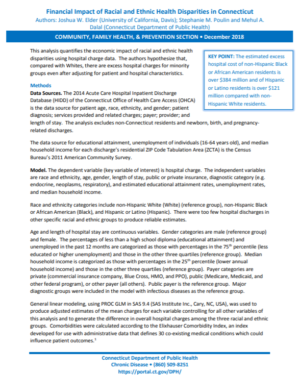Compared to their white counterparts, Black and Hispanic Connecticut residents are more likely to live in poorer health and, for Black residents, to die younger. Yet these disparities are not inevitable and they are not intractable. There are ways to reduce and even eliminate these disparities.
Health Disparities
Overall, Connecticut is one of the healthiest states in the country, but a closer look at the data shows a more troubling picture.
Health Disparities in Connecticut
Racial and ethnic health disparities are pervasive in Connecticut and across the country.

Report
Health Disparities in CT: Causes, Effects, and What We Can Do
This report includes data on health disparities and details on the causes and costs of disparities, an example of how one state eliminated a major disparity, as well as recommendations for CT.

Fact Sheet
Health Disparities in CT
Racial and ethnic health disparities are pervasive in Connecticut. It doesn’t have to be this way. This fact sheet provides an overview of health disparities in the state.

Infographic
Creating a clearer path to better health
For many, staying healthy is part of our routine. For others, particularly people of color, there are more hurdles to getting and staying healthy.
By the Numbers
Black and Hispanic residents have poorer health outcomes than white residents, including higher rates of asthma, diabetes, cancer, and infant mortality. These fact sheets include the most recent data on several conditions.

Fact Sheet
Asthma
Asthma is a chronic condition that disproportionately affects people of color in Connecticut.

Fact Sheet
Cancer
Cancer is one of the leading causes of death in Connecticut and takes a disproportionate toll on Black and Hispanic state residents.

Fact Sheet
Diabetes
Diabetes is a chronic condition that affects nearly one in 10 adults in Connecticut, but has disproportionately devastating effects on Black and Hispanic residents.

Fact Sheet
Infant and Maternal Health
Some of the biggest health disparities exist in infant and maternal health. For example, babies born to Black women are significantly more likely to die before turning one than babies born to white women.
Causes, Costs and Solutions
Health disparities have many causes, including unequal access to health care and other resources needed to stay healthy, unequal treatment within health care, and the physical and mental health consequences of experiencing racism and discrimination. While these are longstanding problems, they are not intractable. There are ways to reduce and even eliminate disparities.

Fact Sheet
Causes: Why do disparities exist?
Racial and ethnic health disparities have many causes. These include unequal access to health care and other resources that influence health, as well as unequal treatment within the health care system and the psychological and physiological effects of racism.

Fact Sheet
Costs: Financial Impact of Racial & Ethnic Health Disparities in CT
Health disparities are costly. This analysis for the CT Department of Public Health quantifies the economic impact of racial and ethnic health disparities based on hospital costs.

Fact Sheet
Solutions: What can we do about disparities?
Racial and ethnic health disparities are longstanding problems in Connecticut, but they are not inevitable. There are steps the state, health systems, and others can take right now to reduce or eliminate these disparities. Here are four steps Connecticut can take.
Research on Disparities

Report
Urban Institute analysis of the ACA’s impact on Connecticut
This analysis by the Urban Institute examines the impact of the Affordable Care Act on Connecticut, including its role in expanding access to coverage for Black and Hispanic residents.

Report
Health Equity in Connecticut 2023
This report by DataHaven looks at the barriers people of color in Connecticut face that lead to poorer health outcomes. The report finds that preventable health problems lead to the excess deaths of Black residents.

Report
The CT Report Card on Health Equity Among Men & Boys of Color
This report by the Health Disparities Institute at UConn Health focuses on men and boys of color, with data on topics including health insurance, preventive health screenings, cancer disparities, behavioral health, life expectancy, and mortality rates.

Report
Towards Health Equity in Connecticut: The Role of Social Inequality & the Impact of COVID-19
This report by DataHaven examines how various groups are affected by factors including education, housing, and health care coverage, and discusses the impact of the COVID-19 pandemic. The report also includes an analysis of local data by race and ethnicity.